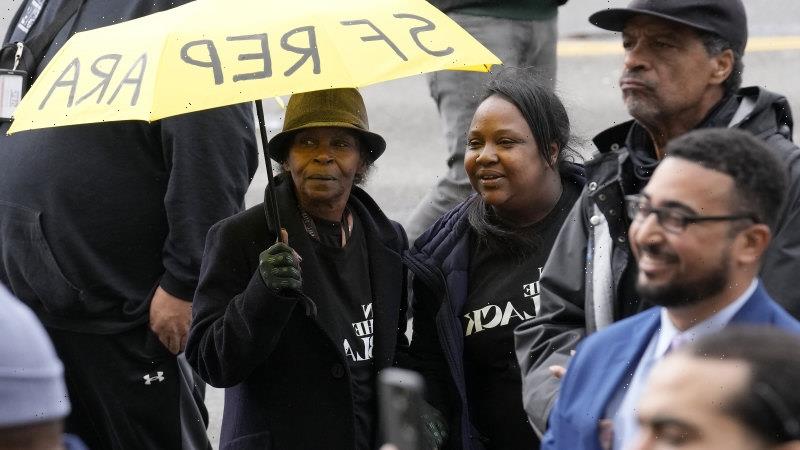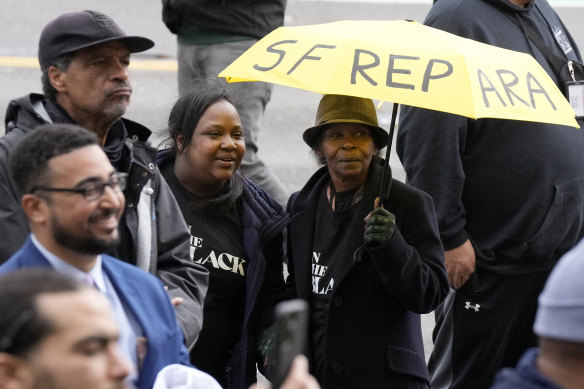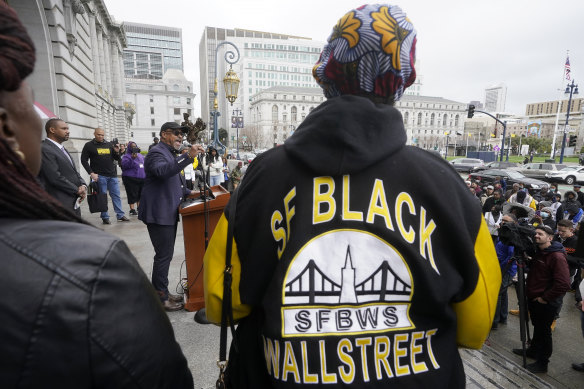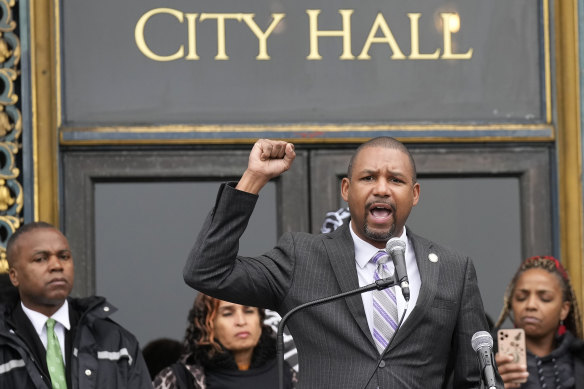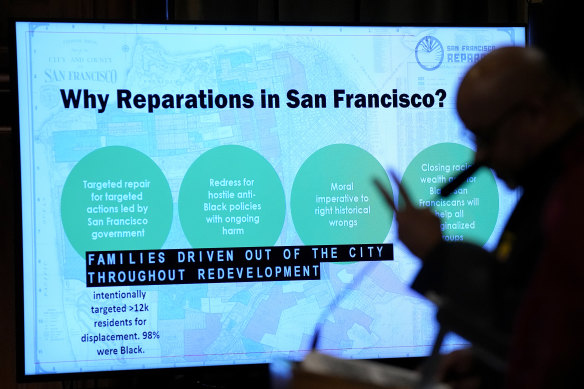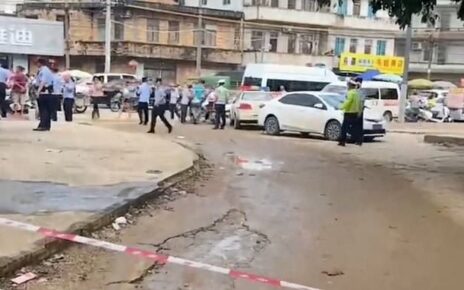San Francisco: Payments of $US5 million ($7.5 million) to every eligible black adult, the elimination of personal debt and tax burdens, guaranteed annual incomes of at least $US97,000 for 250 years and homes in San Francisco for just $US1 a family.
These are just some of the recommendations made by a city-appointed reparations committee tasked with a thorny question: what would it take to atone for the centuries of US slavery and generations of systemic racism that continue to keep black Americans on the bottom rungs of health, education and economic prosperity, and overrepresented in prisons and homeless populations?
Pia Harris, with the San Francisco Housing Development Corporation, second from left, and her mother, Adrian Williams, listen to speakers at a reparations rally outside of City Hall in San Francisco on Tuesday.Credit:AP
A first hearing before the city’s Board of Supervisors on Tuesday could offer a glimpse of the board’s appetite for advancing a reparations plan that would be unmatched nationwide in specificity and breadth. Critics have slammed it as financially and politically impossible. One conservative analyst estimated that each non-black family in the city would have to pay at least $US600,000.
Supervisor Shamann Walton, who is black, opened the hearing by stating the board would not say then “what recommendations we will be supporting or moving forward with”. He also expressed thanks to the committee and the board for delving into an issue that has made him and other reparations supporters the target of racist comments and threats.
“It is not a matter of whether or not there is a case for reparations for black people here in San Francisco. It is a matter of what reparations will and should look like yet,” Walton said, “and still we have to remind everyone why this is so important”.
Some supervisors have said San Francisco can’t afford any major reparations payments right now, given the city’s deep deficit amid a tech industry downturn, worsened by the collapse of the Silicon Valley Bank this week, but they still want to discuss the proposals and consider future solutions. The board can vote to change, adopt or reject any or all the recommendations.
Eric McDonnell, Chair with the African American Reparations Advisory Committee, middle left, speaks at the reparations rally.Credit:AP
But reparations committee members consider their results to be an accurate estimate of what it would take to begin to repair the enduring damage of slavery and discrimination, and they bristle at the idea that they should figure out how to pay for it.
“We are the harmed,” said Eric McDonnell, chair of the San Francisco African American Reparations Advisory Committee. “If the judge ruled in our favour, the judge would not turn to us and say, ‘Help them figure out how to make this work’.”
The idea of paying compensation for slavery has gained traction across cities and universities. In 2020, California became the first state to form a reparations taskforce and is still struggling to put a price tag on what is owed.
The idea has not been taken up at the federal level.
Supervisor Shamann Walton speaks at a reparations rally outside of City Hall in San Francisco.Credit:AP
Fewer than 50,000 black people still live in San Francisco, and it’s not clear how many would be eligible. Possible criteria include having lived in the city during certain time periods and descending from someone “incarcerated for the failed War on Drugs”.
Critics say the payouts make no sense in a state and city that never enslaved black people. Opponents generally say taxpayers who were never slave owners should not have to pay money to people who were not enslaved.
Advocates say that view ignores a wealth of data and historical evidence showing how long after US slavery officially ended in 1865, government policies and practices worked to imprison black people at higher rates, deny access to home and business loans and restrict where they could work and live.
“There’s still a veiled perspective that, candidly, black folks don’t deserve this,” McDonnell said. “The number itself, $US5 million, is actually low when you consider the harm.”
Eric McDonnell, chair of the African American Reparations Advisory Committee, speaks during a special Board of Supervisors hearing the reparations ideas.Credit:AP
Justin Hansford, a professor at Howard University School of Law, says no municipal reparations plan will have enough money to right the wrongs of slavery, but he appreciates any attempts to “genuinely, legitimately, authentically” make things right. And that includes cash, he said.
“If you’re going to try to say you’re sorry, you have to speak in the language that people understand, and money is that language,” he said.
Black residents once made up more than 13 per cent of San Francisco’s population, but more than 50 years later, they account for less than 6 per cent of the city’s residents – and 38 per cent of its homeless population. The Fillmore District once thrived with black-owned nightclubs and shops until government redevelopment in the 1960s forced out residents.
John Dennis, chair of the San Francisco Republican Party, does not support reparations, although he says he’d support a serious conversation on the topic. He doesn’t consider the board’s discussion of $US5 million payments to be one.
“This conversation we’re having in San Francisco is completely unserious. They just threw a number up, there’s no analysis,” Dennis said. “It seems ridiculous, and it also seems that this is the one city where it could possibly pass.”
The board created the 15-member reparations committee in late 2020, months after California Governor Gavin Newsom approved a statewide taskforce amid national turmoil after a white Minneapolis police officer killed George Floyd, a black man.
At Tuesday’s hearing, the board could direct staff to conduct further research, write legislation or schedule more meetings. The committee’s final report is due in June.
California’s taskforce continues to deliberate recommendations, including monetary compensation. Its report is due to the Legislature on July 1. At that point, it will be up to state representatives to draft and pass legislation, often a time-consuming process.
The state panel made the controversial decision in March to limit reparations to descendants of black people who were in the country in the 19th century. Some reparations advocates said that approach misses the ongoing harms that black immigrants suffer.
Under San Francisco’s draft recommendation, a person must be at least 18 years old and have identified as “black/African American” in public documents for at least 10 years. Eligible people must also meet two of eight other criteria, though the list may change.
Those criteria include being born in or migrating to San Francisco between 1940 and 1996 and living in the city for least 13 years; being displaced from San Francisco by urban renewal between 1954 and 1973, or the descendant of someone who was; attending the city’s public schools before they were fully desegregated; or being a descendant of an enslaved US person before 1865.
The Chicago suburb of Evanston became the first US city to fund reparations. It gave money to qualifying people for home repairs, down payments and interest or late penalties due on property. In December, the Boston City Council approved of a reparations study taskforce.
AP
Most Viewed in World
From our partners
Source: Read Full Article
